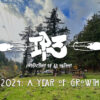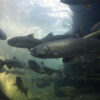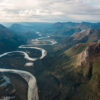Line 3 Update
Line 3 is a proposed pipeline expansion to bring approximately a million barrels of tar sands oil per day, from Alberta, Canada to Superior, Wisconsin. This pipeline was proposed in 2013 by Enbridge, a Canadian pipeline company responsible for the largest inland oil spill in the United States. Enbridge desires to build a new pipeline corridor through the treaty territory of Anishinaabe peoples, where untouched wetlands need not be disturbed, through the Mississippi River headwaters to the shore of Lake Superior, the largest of the Great Lakes of the United States and among freshwater lakes is the third-largest by volume.
6 days ago @resist_line_3 posted this photo of the wild rice beds in Mississippi River looked like before Enbridge came and drilled, and after Enbridge came and drilled. @resist_line_3 states
“East easement from the Mississippi River to the woodline is completely covered in a fresh layer of drilling mud left over from the Enbridge Line 3 project. Closeup of the east easement shows the fresh cloudy grey chemicals rising months after drilling was completed. Today’s release of drilling fluids covers the east easement and a new location further up near the drill pad. The new location of drilling fluids rising to the surface.”
The Enbridge Line 3 pipeline is complete and operating at full capacity, processing 760,000 barrels per day.
Ap news reported “A leading face of the opposition, Winona LaDuke, executive director of the Indigenous-based environmental group Honor the Earth, paid tribute to the many people from across the country who came to Minnesota to protest.
“Your brave efforts about Enbridge’s Line 3 have reshaped the world’s views on the climate crisis we are in, the Treaty Rights of the Anishinaabe, and the escalating divestment in fossil fuels around the world and here at home,” LaDuke said in a statement. “You are the true heroes of this tragic saga.”
At this moment, restoration and cleanup along the Enbridge route. The cleanup will take place well into the summer months.
What now? What tactics and strategies need to change in order for us to protect our homelands and drinking water for future generations? The little wins in each action, are little wins enough? What’s our response when these pipelines fail? What’s next for our movement spaces?









